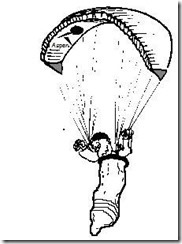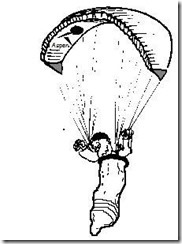It's been a strange and frustrating year for everything; work, home, injury and particularly sport (in
case you are wondering I'm looking for excuses).
I used to climb 2 or 3 times a week, since lock down 3 times total.
Weather during lock down great, since then not so.
I have also managed to find a talent that I thought I had lost - missing the best conditions, usually
limited to weekends anyway but recently it's been “you should have been here 2 hours ago” or “it
got good just after you left”.
So I'm suffering from frustration, much luckier than many people at the moment so really no
excuses, but it's there.
So flying is what we love and we all know it can be dangerous but for me the rewards far out-way
the risks .
It is still worth looking at things we do that put us at risk and frustration is one.
With hindsight, for me the first indication that frustration was starting to over-rule good sense was a
really good forecast on Longridge. I was there for 8am, not wanting to miss anything. For people
that don't know it, Longridge is long, over 3k. Take off faces north but the main face at the east end
faces NNE. The topography also seems to allow the main face to work better, quicker, especially in
lighter conditions.
The wind was a bit light and off to the east but I got ready and started ground handling. The first
stronger bit that came through was too tempting and I went for it, trying to get along to the main
face. More patience would have been sensible, I went down near the bottom of the main face! By
the time I packed up, struggled up the steep face through waist deep heather (I've got short legs),
got ready and launched, the first of the sensible people were just soaring round the corner onto the
main face.
Two really pleasant flights and over 3 hours in the air later I packed up just as conditions went
ballistic and a number of pilots were hoovered up to cloudbase, some soared up the side of the huge
convergence cloud that had formed. As I pulled into my driveway at home my wife was pointing up
at a green and black Artik 5 cruising over my house at cloudbase – how could you do that to me
Scott!
5 days later, a reasonable forecast led me to book a day's holiday. The night before there was some
chat on Whats App and I did say “it might be a bit breezy”. Come the morning and I was up and at
the hill reasonably early. It felt breezy and after a false start with my big wing, I walked up with my
mini wing.
One of our most experienced pilots, Simon B was already on the top, harness and wing out but the
wing still in its bag. We had a chat about the conditions and Simon's comment was that with my
mini wing I probably had the correct wing for the conditions at that time.
Parlick east face has had a number of accidents over the years, some very serious. Where we launch
is a flat section next to the south face that has a sharp edge onto the main east face. To the left is a
shallower slope that runs all the way to Wolf Crags at the north end of the ridge. Out front is Saddle
Fell which is ideally placed to generate wave type effects on Parlick. All of these have the potential
to create unpredictable winds, especially around the launch area.
I wasn't sure about the conditions but I didn't want to walk back down and miss another chance to
fly so decided to ground handle on the top to 'check' the conditions.
I set up about 20 metres back from the edge, pulled up with no problem and it didn't feel too bad,
then it went a bit squirrelly so I collapsed it. I was pulled back as I dropped the wing so was now
about 40 metres back from the edge. I said to Simon I didn't think it was going to be flyable as it
was too strong and gusty but that I would have another go to check.
I pulled up easily, turned to face forward and was immediately snatched up and off to the side by a
huge gust. In a split second I was 15-20 feet up and being pushed back and out over the south face. I
managed to turn into wind, hands up to maximise air speed. I was then slammed down, still going
backwards. I thought 'this is going to hurt', got my legs ready for the impact and prepared to kill the
wing as soon as I hit. It did hurt and I was dragged back a short distance before the wing settled.
Lying there on my side in the quiet my first thought was 'I'm alive that's good, but what damage
have I done?' Simon arrived and made the wing safe, I checked myself over and luckily the only
significant damage was a badly sprained ankle. With Simons help I was able to get me and my gear
off the hill and back home.
OK, so this is the important bit, lessons learned:
- Beware frustration and the 'need' to fly.
- Hindsight is 20/20.
- Know the site and act on the knowledge.
- Remember that the stronger the wind, the worse the turbulence - this is especially important
if you are on a mini wing. - Being back from the edge of the hill doesn't mean you are out of danger, rotor effects can
extend a long way back. - A PLF can save major damage.
- If there is doubt in your mind, wait and monitor the conditions.
- Listen to the voice in your head, if it feels wrong it probably is.
As a footnote, it was flyable a couple of hours later that day and a couple of weeks after my
accident, another of our pilots was airlifted off the hill from a similar incident in almost the same
place. So, please be careful, especially on Parlick east in strong or gusty conditions and if you are
feeling frustrated and desperate to fly.
Also, a big thanks to Simon for the calm and caring help he gave me, it made a big difference.

